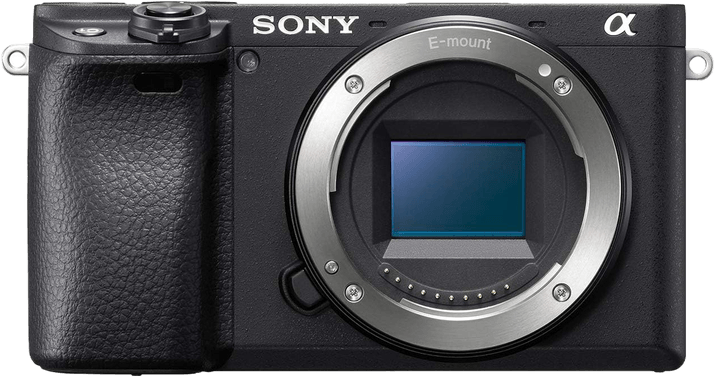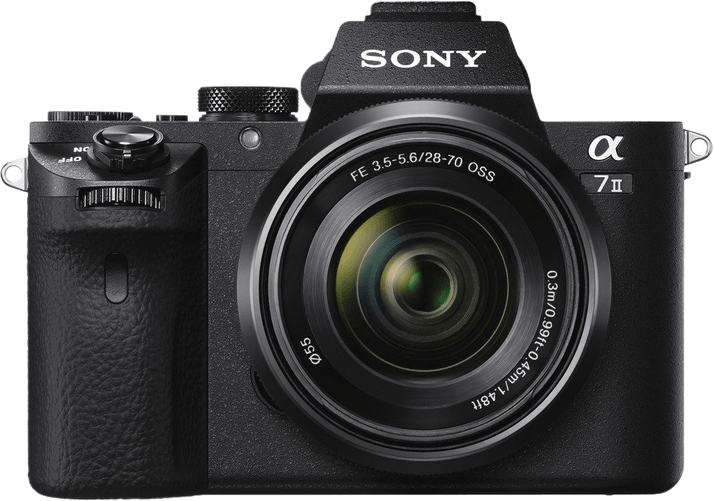Sony a6400 vs a7 II Comparison
Sony a6400

Sony a7 II

The Sony a6400 edges out the Sony a7 II with a score of 70/100 compared to 68/100. Both cameras are mirrorless and share similar dimensions, with the a6400 measuring 120 x 67 x 60mm and the a7 II at 127 x 96 x 60mm. However, the a6400 is lighter at 403g, making it more portable than the a7 II, which weighs 599g.
The a6400 has the advantage of being a more recent release (2019) with a lower launch price of $900, compared to the a7 II’s 2014 release and $1600 launch price. While both cameras have their merits, the Sony a6400 offers a better value with its lower price and lighter weight. The Sony a7 II may still appeal to those who prefer a slightly larger camera body, but the a6400 emerges as the winner in this comparison.
Sony a6400 vs a7 II Overview and Optics
The Sony a7 II comes out on top in our optics comparison with a score of 78/100, while the Sony a6400 receives a score of 68/100. Both cameras share several specifications, including 24.2 megapixels, CMOS sensor type, Bionz X processor, and Sony E lens mount.
The winning camera, Sony a7 II, boasts a higher DXOMARK score for the sensor at 90, compared to the a6400’s score of 83. This difference results in improved image quality from the a7 II. Additionally, the a7 II features a full-frame sensor, which contributes to better low-light performance and increased dynamic range. Another advantage of the Sony a7 II is its built-in image stabilization, allowing for steadier shots and reduced camera shake in various shooting conditions.
On the other hand, the Sony a6400 has a faster shooting speed of 11 frames per second, compared to the a7 II’s 5 frames per second. This makes the a6400 better suited for capturing fast-moving subjects and action photography.
The Sony a7 II’s superior sensor quality and built-in image stabilization make it the better option for photographers seeking optimal image quality and low-light performance. However, the Sony a6400’s faster shooting speed may be more appealing to those who prioritize capturing fast-paced action. Both cameras offer excellent optics, but the a7 II’s advantages in sensor quality and stabilization give it the edge in this comparison.
Sony a6400 vs a7 II Video Performance
The Sony a6400 triumphs over the Sony a7 II in video capabilities, with a video score of 91/100 compared to the Sony a7 II’s 56/100. Both cameras have some similarities in their video features, but the Sony a6400 has several advantages that contribute to its higher score.
Both cameras share max video resolutions, with the Sony a6400 offering 4K (3840 x 2160) and the Sony a7 II providing Full HD (1920 x 1080). Additionally, they both have max video frame rates, with the Sony a6400 reaching 120fps and the Sony a7 II at 60fps.
The Sony a6400 outperforms the Sony a7 II due to its higher max video resolution, allowing for more detailed and crisp footage. Its max video frame rate of 120fps also enables smoother slow-motion video capture, providing more creative possibilities for videographers. Furthermore, the Sony a6400 has built-in time-lapse functionality, which is absent in the Sony a7 II. This feature allows users to create stunning time-lapse videos without the need for additional software or equipment.
The Sony a7 II, on the other hand, has limited advantages in its video capabilities compared to the Sony a6400. Its lower max video resolution and frame rate result in less detailed footage and fewer creative options for videographers.
Considering the significant differences in video capabilities, the Sony a6400 is the superior choice for those prioritizing video performance. Its higher max video resolution, frame rate, and built-in time-lapse functionality make it a more versatile and powerful tool for capturing high-quality video content. The Sony a7 II, with its lower video score, is less suitable for those who require advanced video features and may be better suited for photographers who do not prioritize video capabilities.
Sony a6400 vs a7 II Features and Benefits
The Sony a6400 emerges as the winner in the features category with a score of 81/100, while the Sony a7 II trails behind with a score of 57/100. Both cameras share some common specifications, such as a 3-inch screen size, flip screen, absence of GPS, and WIFI connectivity.
The Sony a6400 outperforms the a7 II in several aspects. The a6400 has a touchscreen, allowing users more intuitive control and easier navigation through the camera’s settings. Additionally, the a6400 offers Bluetooth connectivity, which facilitates seamless file transfers and remote control of the camera using a smartphone. These features contribute to the a6400’s higher score and enhance the overall user experience.
On the other hand, the Sony a7 II has a higher screen resolution of 1,230,000 dots compared to the a6400’s 921,600 dots. This results in sharper and more detailed image previews on the a7 II’s screen. However, the lack of a touchscreen and Bluetooth connectivity hampers its overall feature score.
To sum up, the Sony a6400 emerges as the better camera in terms of features due to its touchscreen capability and Bluetooth connectivity. These advantages make the a6400 a more user-friendly and versatile option. Although the Sony a7 II offers a higher screen resolution, it falls short in other essential features, resulting in a lower score.
Sony a6400 vs a7 II Storage and Battery
The Sony a6400 outperforms the Sony a7 II in storage and battery. Both cameras have a single memory card slot and accept SD/SDHC/SDXC and Memory Stick Duo cards. However, the a6400 is compatible with UHS-I cards, while the a7 II also supports Pro Duo and Pro-HG Duo cards.
The a6400 has a longer battery life, providing 410 shots per charge, while the a7 II only offers 350 shots. They both use the NP-FW50 battery type.
Despite the a7 II’s lower score, it still offers compatibility with a wider range of memory cards. Nevertheless, the a6400’s longer battery life and USB charging make it the better choice for storage and battery performance.
Sony a6400 vs a7 II Alternatives
Still not sure which camera is for you? Get inspired by these trending camera comparisons:
